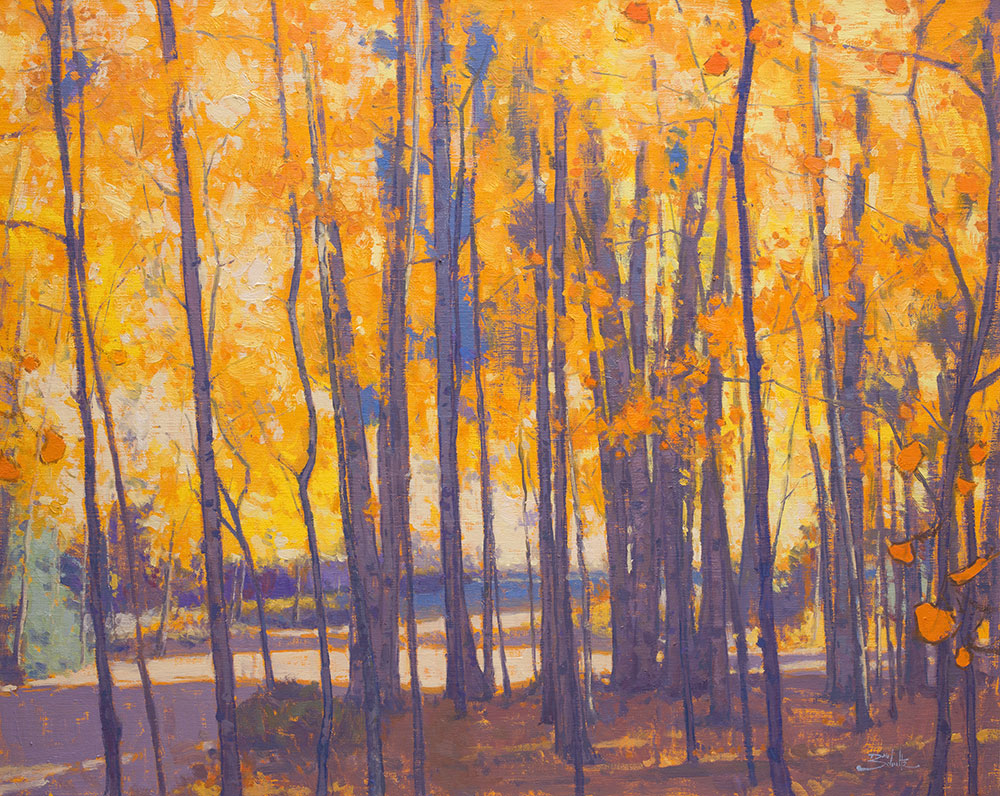The Three Characteristics of Color:

1. Value
Value is the degree of lightness or darkness of a color. Every color has its own inherent value.
2. Hue
Hue is the name of any given color (i.e. cadmium orange, ultramarine blue, etc.). I sometimes think of hue as the color family of a particular color.
3. Intensity
Intensity is the purity or saturation of a color. Colors are at their maximum intensity when squeezed out of the tube.
Once we identify colors we see using the above characteristics, we can more easily understand how to mix them with our paint.
Understanding Color Intensity
When I begin a painting, I find it helpful to identify the most intense colors in the scene I’ve chosen to paint. Knowing this helps me as I mix my colors to achieve proper relationships between the more intense and less intense colors.
The less intense colors almost always have some percentage of each primary color (red, yellow and blue) in their mixtures, which reduce intensity when mixed together. I’ve found that realization to be particularly helpful. When we mix two complementary colors together to reduce intensity, we’re actually mixing all three primary colors together. For example, when we add a bit of red to a green mixture to reduce the intensity of the green, we’ve actually mixed red with yellow and blue (the green).
But when mixing the most intense colors, I’m careful not to add unnecessary colors into those mixtures. The more intense colors often don’t have more than two of the primary colors included. If they do include the third primary color, it’s a very small percentage.
Getting There
Having trouble recognizing color intensity? The best way to improve your color recognition overall is to paint a lot. I think painting outside (plein air painting) will generate improvement the fastest.
Each time you paint, take the necessary time to do your best to match the colors you’re mixing with the colors in your scene.
You can also make a set of color charts. It’s a tedious exercise, but it will help you understand all the color combinations that are possible from your chosen palette colors.I hope these thoughts will help you on your way toward understanding color intensity. Keep your brushes moving!
Value is the degree of lightness or darkness of a color. Every color has its own inherent value.
2. Hue
Hue is the name of any given color (i.e. cadmium orange, ultramarine blue, etc.). I sometimes think of hue as the color family of a particular color.
3. Intensity
Intensity is the purity or saturation of a color. Colors are at their maximum intensity when squeezed out of the tube.
Once we identify colors we see using the above characteristics, we can more easily understand how to mix them with our paint.
Understanding Color Intensity
When I begin a painting, I find it helpful to identify the most intense colors in the scene I’ve chosen to paint. Knowing this helps me as I mix my colors to achieve proper relationships between the more intense and less intense colors.
The less intense colors almost always have some percentage of each primary color (red, yellow and blue) in their mixtures, which reduce intensity when mixed together. I’ve found that realization to be particularly helpful. When we mix two complementary colors together to reduce intensity, we’re actually mixing all three primary colors together. For example, when we add a bit of red to a green mixture to reduce the intensity of the green, we’ve actually mixed red with yellow and blue (the green).
But when mixing the most intense colors, I’m careful not to add unnecessary colors into those mixtures. The more intense colors often don’t have more than two of the primary colors included. If they do include the third primary color, it’s a very small percentage.
Getting There
Having trouble recognizing color intensity? The best way to improve your color recognition overall is to paint a lot. I think painting outside (plein air painting) will generate improvement the fastest.
Each time you paint, take the necessary time to do your best to match the colors you’re mixing with the colors in your scene.
You can also make a set of color charts. It’s a tedious exercise, but it will help you understand all the color combinations that are possible from your chosen palette colors.I hope these thoughts will help you on your way toward understanding color intensity. Keep your brushes moving!
Write your awesome label here.
